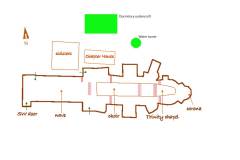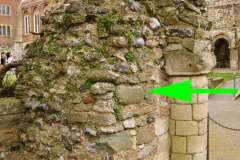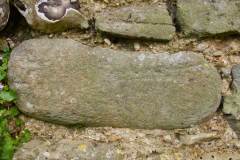Basics
Geology: coarse calcareous sandstone
Rock unit: The Folkestone Formation
Age: Lower Cretaceous
Provenance: Folkestone
Where to see examples
dormitory undercroft
Description
The Folkestone Formation lies within the Lower Greensand Group and in Kent outcrops south-east to north-west from Folkestone towards Sevenoaks. The Formation is named from the coastal outcrop. The stones found at Canterbury are from Folkestone itself, either quarried from the coastline cliffs or from the valley sides of the Pent Stream. At its eastern-most outcrop the beds are mostly well cemented calcareous sandstones consisting of coarse, gritty sands with occasional large grains of the green iron mineral glauconite. The stone’s recognised durability led to the development of a local millstone industry at East Wear Bay. Here too, the hard nature of the beds formed the coastal headland at Copt Point.
Folkestone Stone was transported by boat from Folkestone northwards through the Wantsum Channel to the port of Fordwich, from whence the loads were taken by cart to the cathedral precincts. The stone has been used in the cathedral fabric as a rubble stone and examples can best be seen in the walls of the dormitory undercroft. The stone was also used for castle building at Dover, Deal and Sandown and locally for the Parish Church of St Mary & St Eanswythe in Folkestone, as well as the town’s harbour walls.
Click on the images below to enlarge and read captions.



